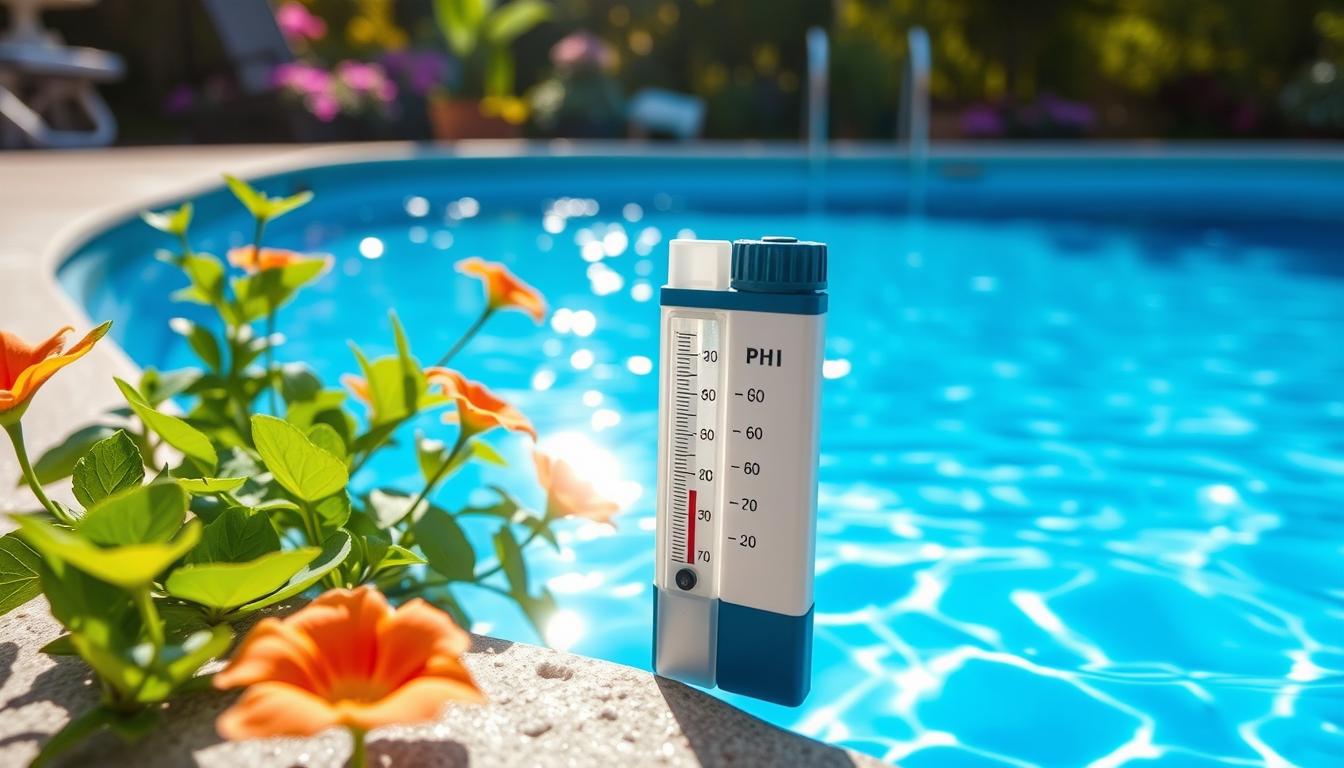
Keeping the right pH level is vital for a safe swimming pool. The ideal pH range is 7.4 to 7.6. This ensures comfort for swimmers and protects pool surfaces and equipment.
Regular testing and adjusting of pH levels keep pools in top shape. This practice extends the pool’s lifespan and maintains its inviting appearance.
Pool chemistry is crucial for maintaining the perfect pH level. Expert tips can help achieve this balance easily. Weekly water testing is a key part of this process.
Using the right products to adjust pH levels is important. These practices keep pools clean, clear, and inviting for all swimmers.
Key Takeaways
- The ideal pH range for pool water is between 7.4 and 7.6.
- Regular testing and adjusting of pool water pH is essential for maintaining water balance.
- Proper pool maintenance helps extend the lifespan of the pool and its components.
- Balancing pool water ensures the effectiveness of chlorine in sanitizing the pool.
- Pool owners should test their water’s pH at least once a week and make necessary adjustments using pH increasers or decreasers.
Understanding the Importance of Pool pH Balance
Keeping your pool’s pH balanced is vital for a safe swim. The pH scale goes from 0 to 14, with 7 being neutral. For pools, aim for a pH between 7.2 and 7.8.
This range protects pool surfaces and equipment. It also ensures proper sanitation and reduces eye and skin irritation for swimmers.
Ideal pH Range for Swimming Pools
The perfect pH for pools falls between 7.2 and 7.8. This range keeps swimmers safe and comfortable. It also protects pool surfaces and lets chlorine work well.
- It ensures a safe and comfortable swimming environment for pool users
- It helps prevent damage to pool surfaces and equipment
- It allows chlorine to work effectively in sanitizing the pool water
Test your pool’s pH at least once a week. Do this more often during peak swim season and after heavy rain. Regular checks help you spot changes and make needed adjustments quickly.
Effects of High and Low pH Levels
When your pool’s pH is off, problems can arise. Both high and low levels cause issues for swimmers and the pool itself.
| pH Level | Effects on Pool and Swimmers |
|---|---|
| Low pH (below 7.2) |
|
| High pH (above 7.8) |
|
Incorrect pH can harm swimmers and damage the pool. Be careful not to overcorrect by adding too many chemicals at once. Make small changes and retest often.
Relationship Between pH and Chlorine Effectiveness
Your pool’s pH level affects how well chlorine cleans the water. Chlorine works best when the pH is between 7.2 and 7.8.
High pH makes chlorine less active against bacteria. Low pH causes chlorine to dissipate quickly, requiring more frequent additions.
Keeping the pH level within the ideal range of 7.2 to 7.8 ensures that chlorine works effectively to keep the pool water clean and safe for swimming.
How to Maintain Pool pH Level: Step-by-Step Guide
The right pH level in your pool is vital for safe swimming. Let’s explore how to test, adjust, and maintain your pool’s pH balance.
Testing Pool Water pH
Regular testing is key to keeping proper pool pH levels. Pool owners can use test strips, liquid test kits, or digital testers.
Test your pool water’s pH at least once a week. Do it more often during heavy use or after big weather events.
- Pool test strips are the most convenient, requiring only a quick dip in the water and a comparison of the resulting color to a provided chart.
- Liquid test kits involve adding water samples to reagents and comparing the color to a chart, offering a more precise reading.
- Digital testers provide the most accurate results but come at a higher cost.
Adjusting pH Levels
If your pool water pH isn’t between 7.4 and 7.6, it’s time to make changes. Use pH increasers or decreasers to adjust the levels.
| Condition | Solution | Products |
|---|---|---|
| Low pH (below 7.4) | Raise pH level | Sodium carbonate (soda ash) or sodium bicarbonate (baking soda) |
| High pH (above 7.6) | Lower pH level | Muriatic acid or sodium bisulfate |
Always follow the maker’s instructions when adding chemicals. Add them slowly to avoid going past the desired pH level.
After adjusting, retest the water in a few hours. This ensures the pH has settled within the right range.
Maintaining Proper pH Balance
Keep your pool water pH levels steady with a regular maintenance plan. Test pH weekly and make small changes as needed.
Small, frequent adjustments are better than big, costly fixes. This approach saves time and money in the long run.
Pro Tip: In addition to regular pH testing and adjusting, monitor your pool water’s total alkalinity. Proper alkalinity levels help stabilize the pH level over time, making it easier to maintain the ideal range.
A balanced pH and alkalinity create a safe, comfy pool. Your family will love swimming in clear, inviting water all season long.
Conclusion
Proper pool pH balance is crucial for safe swimming and equipment protection. Regular testing and gradual adjustments help maintain the ideal pH range of 7.2 to 7.8. This optimizes chlorine effectiveness and prevents damage to pool components.
A consistent maintenance routine is key to avoiding costly repairs. It extends the life of your pool and keeps the water clear. Understanding pH balance’s importance helps pool owners take proactive steps.
Regular testing and maintenance create a sparkling, inviting pool all season long. This ensures safe swimming conditions for family and friends. Staying informed about pool care helps you build a backyard oasis for years of enjoyment.







